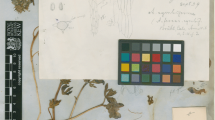Abstract
Of the two dozen species of aconite native to India, thirteen are known to possess drug value. Some of the latter are in commercial trade and offer valuable substitutes for the more commonly used species of Europe. Their nomenclature is revised in this article, with proper consideration given to their habitats and chemical constituents in order to facilitate identification and standardization of this drug.
Similar content being viewed by others
Literature Cited
Brühl, P., and King, G. A century of new and rare Indian plants. Ann. Royal Bot. Gard., Calcutta5: 71–170. 1896. [p. 109–114].
Chopra, R. N. Indigenous drugs of India. p.47. 1939.
Coun. Sci. and Ind. Res. The wealth of India. Vol. 1: 24–28. 1948.
Hamilton [formerly Buchanan Francis]. Account of the Kingdom of Nepal. p. 98–100. 1819.
Henry, T. The plant alkaloids, p. 673. 1949.
Stapf, O. The aconites of India. Ann. Roy. Bot. Gard., Calcutta10(2): 115–197. 1905.
Watt, G. Dictionary of economic products of India. p. 86–98. 1889.
-. Commercial products of India, p. 18-24. 1908.
Author information
Authors and Affiliations
Rights and permissions
About this article
Cite this article
Chakravarty, H.L., Chakravarti, D. Indian aconites. Econ Bot 8, 366–376 (1954). https://doi.org/10.1007/BF02908610
Issue Date:
DOI: https://doi.org/10.1007/BF02908610




